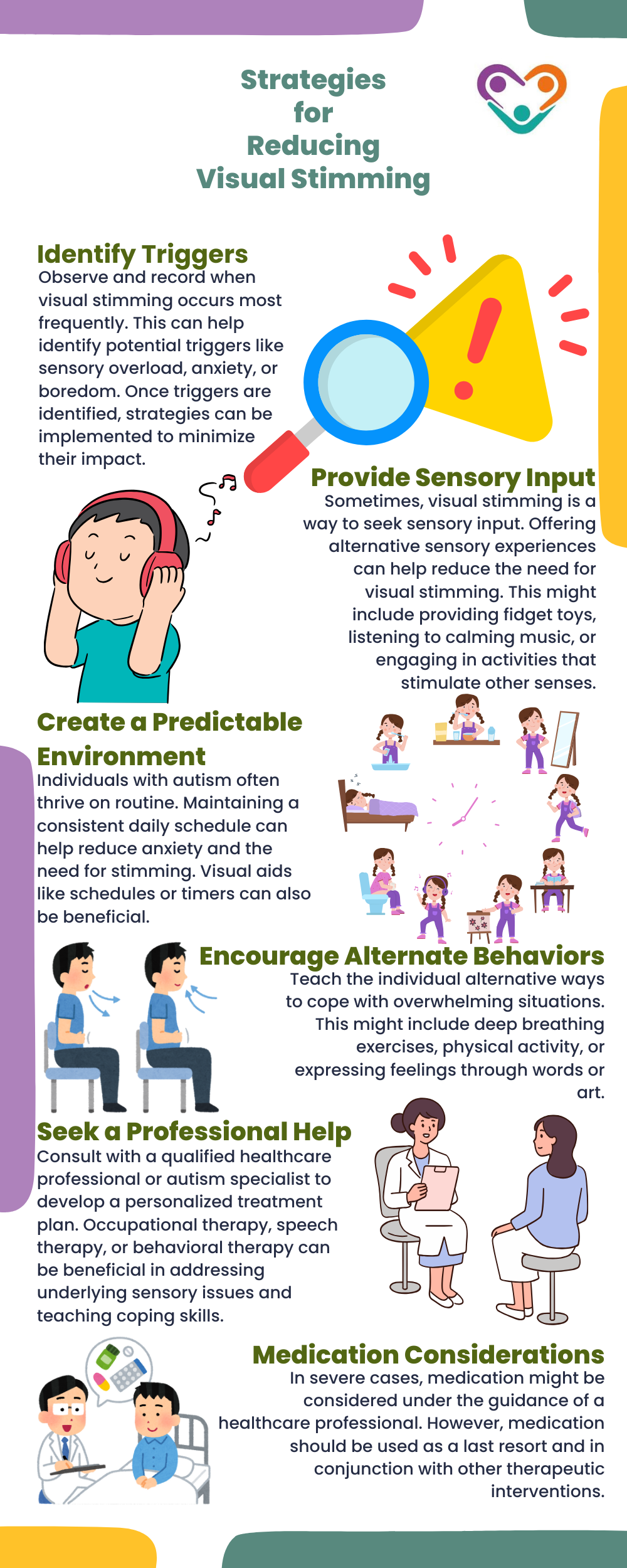Stimming, or self-stimulatory behavior, is a common characteristic in individuals with autism. It involves repetitive actions, often involving movement, sounds, or objects. While stimming can serve various purposes, such as self-regulation or sensory input, excessive visual stimming can sometimes interfere with daily life.
Visual Stimming: A Closer Look
Visual stimming, a specific type of self-stimulatory behavior, involves repetitive actions focused on visual stimuli. Common examples include staring at lights, moving objects back and forth, or fixating on patterns. While it might appear unusual to others, visual stimming serves a crucial purpose for individuals with autism.
Understanding the underlying reasons for visual stimming can help in developing effective strategies. Some individuals might engage in visual stimming to seek sensory input, while others might use it to avoid sensory overload. Additionally, visual stimming can be influenced by emotional states, such as anxiety or excitement.
For many autistic individuals, visual stimming is a way to self-regulate and manage sensory input. It helps them process information, find comfort in predictability, and cope with overwhelming environments. The repetitive nature of visual stimming can provide a sense of calm and control, allowing individuals to focus and concentrate better.
However, excessive visual stimming can interfere with daily life, social interactions, and learning. It might hinder an individual’s ability to engage with others, participate in activities, or acquire new skills. It’s essential to find a balance between accepting visual stimming as a natural behavior and addressing potential challenges.
Impact of Visual Stimming
Visual stimming, like other forms of stimming, serves a purpose. It can provide comfort, self-regulation, and a means of expressing emotions. For some, it’s a coping mechanism to manage sensory overload or emotional distress. However, excessive visual stimming can interfere with daily life, social interactions, and learning.
While stimming often helps individuals manage their emotions and sensory experiences, it’s essential to remember that it can also have negative impacts. For instance, excessive visual stimming might hinder a person’s ability to focus, engage in conversations, or participate in social activities, leading to feelings of isolation.
Moreover, visual stimming can be a symptom of underlying sensory processing difficulties. Individuals with autism often have challenges processing visual information. They might struggle with tracking moving objects, perceiving details, or understanding visual cues. These difficulties can contribute to increased visual stimming as they seek to make sense of their visual environment.
It’s important to note that while visual stimming can be challenging, it’s not a behavior to be suppressed or eliminated entirely. Instead, the focus should be on creating a supportive environment, understanding the individual’s needs, and providing alternative strategies to manage sensory input.
Strategies for Reducing Visual Stimming
While visual stimming is a natural part of autism, there are strategies to help manage it if it becomes excessive or disruptive. Understanding the underlying reasons for the behavior is crucial.

Remember, the goal is not to eliminate stimming entirely but to help individuals manage it effectively. By understanding the underlying causes and implementing appropriate strategies, it’s possible to create a supportive environment that allows individuals to thrive.
Biomedical Treatment Options
One area of focus is the role of G proteins and mitochondria. These tiny cellular powerhouses are crucial for visual processing. When G proteins are damaged, mitochondrial function can be impaired, leading to difficulties in processing visual information. This imbalance might contribute to visual stimming behaviors.
Another factor is methylation, a biochemical process essential for brain development. Deficiencies in methylation can affect the myelination of nerves, impacting how the brain processes visual information.
To address these underlying issues, some individuals with autism may benefit from biomedical treatments. Vitamin A supplementation has shown promise in improving visual motor skills, reducing visual stimming, and enhancing social interaction. It’s essential to note that this specific form of vitamin A is different from standard over-the-counter supplements.
However, it’s crucial to approach biomedical treatments with caution and under the guidance of qualified healthcare professionals experienced in autism. Not all individuals with autism will respond to the same treatments, and it’s essential to consider the specific needs and circumstances of each person.
While biomedical treatments offer potential benefits, they should be seen as part of a comprehensive approach to managing visual stimming. Combining these treatments with behavioral therapies, environmental modifications, and sensory interventions can provide a more holistic approach to supporting individuals with autism.
Supporting Individuals with Stimming
Stimming is a natural part of autism, serving as a way for individuals to regulate their emotions, process sensory information, and find comfort. To create a supportive environment, it’s crucial to foster understanding and acceptance.

Social Acceptance
One of the biggest challenges faced by individuals who stim is societal misunderstanding. Stimming is often seen as unusual or disruptive, leading to social isolation and pressure to suppress these behaviors. It’s essential to challenge these misconceptions.
Education and awareness can significantly impact how others perceive stimming. By understanding that stimming is a form of communication and self-regulation, we can create a more inclusive environment.
Encouraging open conversations about stimming can help reduce stigma. Sharing personal stories and experiences can foster acceptance. It’s important to remember that everyone has unique ways of coping, and stimming is just one of them. By validating these behaviors, we empower individuals to be themselves without fear of judgment.
Stim Toys and Tools
Stim toys can be invaluable in supporting individuals with stimming behaviors. These objects provide alternative and often safer outlets for sensory stimulation. By offering a variety of textures, sounds, and visual elements, stim toys can help individuals regulate their emotions and reduce anxiety.
From fidget spinners and stress balls to chewable jewelry and sensory cubes, the options are diverse. It’s essential to involve the individual in choosing stim toys to ensure they meet their specific needs. Incorporating stim toys into daily routines can help normalize their use and reduce potential embarrassment or discomfort.
If you’re seeking professional support for your child’s stimming behaviors, consider ABA therapy. Golden Care offers high-quality ABA therapy services in NYC, Indiana, New Jersey, Georgia, and Florida. Our experienced therapists create personalized treatment plans to help children reduce challenging behaviors.
Contact us today to learn more about how we can help your child thrive!



